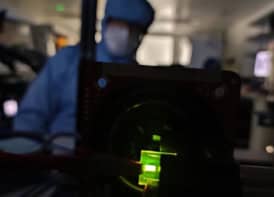
Physicists around the world are gearing up for the International Year of Light and Light-based Technologies (IYL), which kicks off later this month at an official opening ceremony at the headquarters of the United Nations Educational, Scientific and Cultural Organization (UNESCO) in Paris. Some 1500 delegates are set to converge on the French capital for the event, which runs from 19 to 20 January, and will include representatives from the UN and UNESCO as well as the Nobel laureates Zhores Alferov, Steven Chu, Serge Haroche and William Phillips. Designed to highlight how light and light-based technologies touch every aspect of our lives, the IYL will involve more than 100 partners from 85 countries – including the Institute of Physics (IOP), which publishes Physics World.
The UN has declared “international years” since 1959 to draw attention to topics deemed to be of worldwide importance. In recent years, there have been a number of successful science-based themes, including physics (2005), astronomy (2009), chemistry (2011) and crystallography (2014), with the idea for a celebration of light having been initiated by the European Physical Society (EPS) in 2009.
Photonics is a technology that underpins modern life and provides real solutions to global problems
John Dudley, European Physical Society
“We began the IYL focusing primarily on outreach and education, but we rapidly realized that there was a political dimension that we hadn’t appreciated,” John Dudley, president of the European Physical Society (EPS), told Physics World. “Photonics is a technology that underpins modern life and provides real solutions to global problems, and we need to make sure that this is fully appreciated on all levels. We also need to stress that research can take decades before practical outcomes are apparent; a strategic long-term vision is required in investing in research and technology.”
Marking several anniversaries
This year was picked to celebrate light because it marks a number of anniversaries, including 1000 years since the publication of the work on optics by Ibn al-Haytham, during the Islamic Golden Age. The year also marks 200 years since Augustin-Jean Fresnel’s seminal paper introducing the notion of the wave nature of light, 150 years since James Clerk Maxwell’s work on electromagnetism that paved the way for technologies from lasers to mobile phones, as well as the centenary of the incorporation of the speed of light as an essential part of our description of space and time in Einstein’s equations of general relativity.
“One of the most exciting aspects of this International Year is the way in which it brings together such a wide range of different communities, from astronomy to medicine and photonics to arts and culture,” says Beth Taylor, chair of the UK National Committee for the IYL. “It creates a unique opportunity to cross traditional cultural divides and engage new and different audiences with the excitement of light and its applications.”
Worldwide events
The IYL will consist of a series of co-ordinated events around the world to communicate the importance of light and optical technologies in society – ranging from the Story of Light Festival in Goa, India, to Worldwide Pinhole Photography Day.
While Dudley does not want to single out any specific event, he says that the opening ceremony will be “high profile” to make an impact on a political level. “There are many wonderful and varied things happening and we will see many different outcomes in many different countries,” he says.
Hundreds of events are planned in countries all around the world. In the UK, a launch event will be hosted by the Duke of York, who is UK patron for the year, at St James’s Palace on 28 January. It is expected to highlight the strength of the photonics sector in the UK, which is worth some £10.5bn to the economy. The year will also feature events that monitor light pollution, while talks and exhibitions will be held aimed at educating the public about light-based technologies.
Proud legacy
Taylor says she is “particularly inspired” by the IYL’s Study after Sunset initiative, which aims to promote the use of solar lanterns in regions where there is little or no reliable source of light. “If we can help to make a difference to the uptake of solar lighting by families in the developing world with no current access to safe, clean, affordable light, we will ensure that the IYL leaves a real legacy after 2015, of which we can all be very proud,” she told Physics World.
The IYL was officially launched by the EPS during the Passion for Light workshop held in Varenna, Italy, on 16 September 2011, which was attended by more than 100 physicists and officials from UNESCO. A resolution endorsing the IYL was first adopted by UNESCO in October 2012 and submitted to the UN in November 2013. At the 68th session of the UN General Assembly in Paris in September 2013, the resolution was then adopted to declare 2015 the International Year of Light and Light-Based Technologies.
While officials are firmly focused on the myriad of events happening this year, Dudley, for one, is setting his sights beyond 2015. “One of the pleasures of organizing the IYL over the last few years has been to see the emergence of the next generation of leaders in education and public communication of science,” he says.
- A free-to-read collection of our 10 favourite features on light from Physics World will be available later this month online via the digital version of the magazine or via the Physics World app, available from the App Store and Google Play



